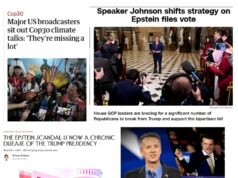What went wrong at BP Deepwater Horizon? President Obama has said repeatedly that whoever is responsible for the spill will pay to clean it up, and the evidence points so far to BP (formerly British Petroleum)—- but the mantra in the media is: wait for the final report. One investigative reporter has already published his own findings. Greg Palast, writing here on 7 May says that the primary culprit in the recent Gulf oil spill is BP, the same outfit which was ultimately responsible for the Exxon Valdez Prince William Sound spill cleanup back in 1989—- and both times were botched jobs because “BP is cheap. Deadly cheap.”
According to Palast, BP both times was charged with carrying out the “OSRP,” or Oil Spill Response Plans, which are drawn up by the company and filed with the government. The key to containing an oil spill is rapid response, which means having crews on standby at all times, just like a fire department. The system is simple, but definitely not inexpensive, because it includes having plenty of rubber containment booms, helicopters, trained workmen, and containment barges at the ready. In Alaska, BP, as principal owner of the Alyeska pipeline consortium, certified that it had all this at the ready, including specially trained Native Alaskans, all at Bligh Island within 5 hours’ sailing time of any point in Prince William Sound.
BP lied, says Palast bluntly. When the Exxon Valdez ran aground, there were no booms at all there, BP had fired those Native Alaskans and replaced them with “phantom crews,” and the barge was in drydock 12 hours away. Because of BP’s failure to respond promptly, 1,200 miles of shoreline were slimed (and the fishing livelihood of the Native Alaskans was destroyed).
And what about the Deepwater Horizon spill? Last year, BP’s CEO, Tony Hayward, “boasted that, despite increased oil production in exotic deep waters, he had cut BP’s costs by an extra one billion dollars a year. Now we know how he did it,” writes Palast, explaining that once again BP has cut corners, lied, and fabricated another phantom OSRP in order to save money.
Palast interviewed Daniel Becnel, Jr., a Louisiana lawyer who represents oil workers on those deepwater platforms. Becnel told him that the spill response crews were told they were not needed because BP had already sealed the well—- that was a lie. He said one of the platform workers told him privately that BP had drilled the well deeper than the 18,000 feet it reported, but failed to inform Halliburton, whose workmen were pouring the cement to seal the well, so Halliburton, unaware of the deeper well, poured too small a cement cap to withstand the higher pressure at the extra depth, and that was probably the reason the well blew. Halliburton, by the way, failed to check on the depth, so they, too, were negligent.
Where were BP’s required containment booms and barge? Too little, too late again. The US Coast Guard frantically tried to make up for BP’s failures. Is was the USCG which picked up the evacuation capsule, began laying their own containment booms, and burned off some of the escaping oil.
How did it come to this, that BP could again and again get away with such lies and negligence? Palast blames the “anti-regulatory mania which has infected the American body politic.” Americans despise government regulations and what he calls “the little bureaucrat with the fat rule book”—– until, that is, something goes wrong, and then those same Americans demand instant government help. While Palast does not name names, it is clear that the de-regulation festival under Reagan, the Bushes, and, yes, Clinton, is the reason BP’s CEO could cut corners, lie, and be so lazy and lax about his company’s responsibilities.



![Saturday News: “Trump’s latest tariff TACO probably won’t make your life more affordable”; “The Epstein Email Cache: 2,300 Messages, Many of Which Mention Trump”; “[MTG] questions if Trump is still the ‘America First’ president”; “Jim Ryan tells all: ‘What did the Governor know, when did he know it?’”](https://bluevirginia.us/wp-content/uploads/2025/11/montage1115-238x178.jpg)







![Saturday News: “Trump’s latest tariff TACO probably won’t make your life more affordable”; “The Epstein Email Cache: 2,300 Messages, Many of Which Mention Trump”; “[MTG] questions if Trump is still the ‘America First’ president”; “Jim Ryan tells all: ‘What did the Governor know, when did he know it?’”](https://bluevirginia.us/wp-content/uploads/2025/11/montage1115-100x75.jpg)

